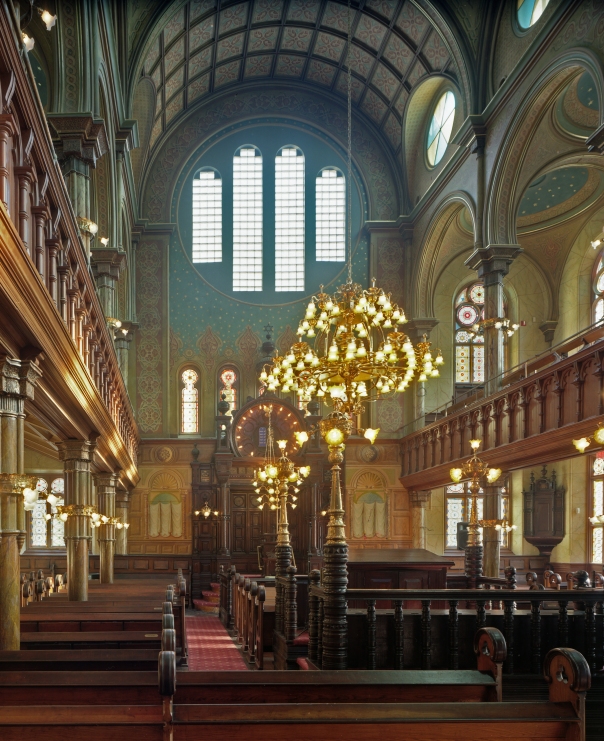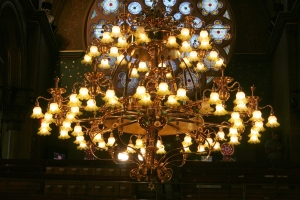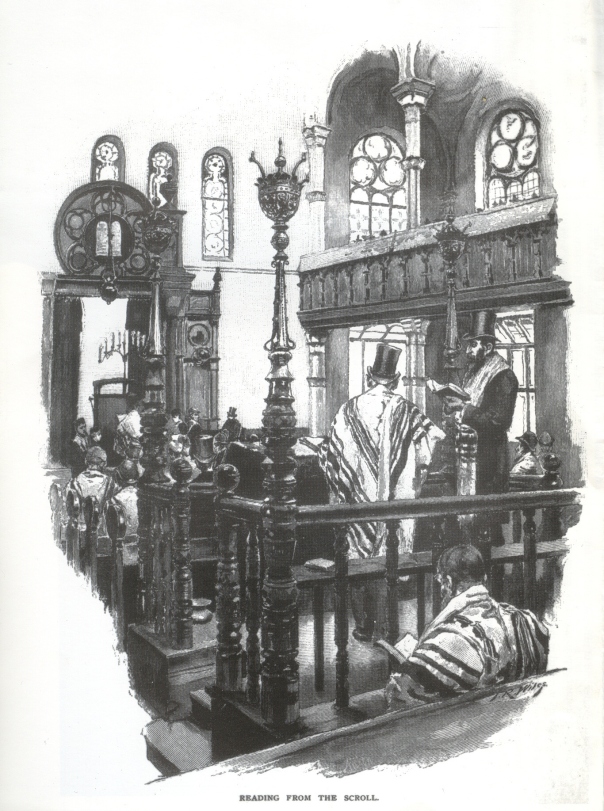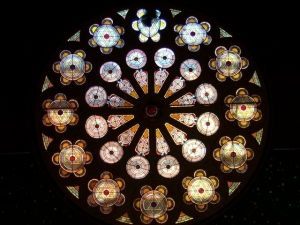![[St. George, Children's Room] Picture Book. NYPL.](https://landmarklearning.files.wordpress.com/2010/07/children-reading.jpg?w=300&h=224)
There are many books available to support a study of Jewish life. Below is a listing of some our favorite nonfiction and fiction literature.
Know of another book that belongs in this list? Please comment below and share your ideas with fellow educators.
NONFICTION
On Synagogues…
What You Will See Inside a Synagogue
Author: Eric A. Kimmel
Grades: 3-6
About: This book emphasizes the Synagogue’s core purpose as a house of prayer, learning, and community and focuses on the weekly Shabbat service, holidays, and life cycle events. 31 pp; illustrated. Excerpted from School Library Journal.
Landmark of the Spirit: The Eldridge Street Synagogue
Author: Annie Polland
Grades: High School and beyond
About: The complete and fascinating history of the rise, the near fall, and the rise again of Eldridge Street Synagogue on New York’s Lower East Side. 192 pp; illustrations and photographs.
American Synagogues: A Century of Architecture and Jewish Community
Author: Samuel Gruber
Grades: High School and beyond
About: How was Jewish history expressed in 20th century synagogue design? This architectural tour includes synagogues designed by Frank Lloyd Wright, Philip Johnson, and Minoru Yamasaki. 240 pp; photographs by Paul Rocheleau. Excerpted from Amazon.
And I Shall Dwell Among Them: Historic Synagogues of the World
Author: Yom Tov Assis
Grades: High School and beyond
About: The architectural diversity of these historic synagogues not only reflect the countries they were built in, but they also reveal the Jewish story of migration and survival. 176 pp; photographs by Neil Folberg.
On Jewish Symbols…
Sofer: The Story of a Torah Scroll
Author: Eric Ray
Grades: Middle School
About: Children learn how a sofer (scribe) makes mezuzot, tefillin, and the sefer Torah. This book is somewhat text heavy, but can serve as a useful reference. 32 pp; photographs.
Menorahs, Mezuzas, and Other Jewish Symbols
Author: Miriam Chaikin
Grades: Grades 4-6
About: From the Star of David to the yarmulke; from numbers to angels to stars, this book explores the significance of familiar – and less familiar symbols – in Jewish life. 112 pages; illustrations.
On Jewish Ritual…
Bar Mitzvah: A Jewish Boy’s Coming of Age
Author: Eric A. Kimmel
Grades: 6-8
About: Kimmel describes the reason for the coming-of-age ceremony; what happens before and during it; its origins and transformations throughout Jewish history. The author includes facts about the sacred books of the Jews, Christians, and Muslims and looks at the similarities and differences in the three religions. Pages 160; illustrations. Excerpted from School Library Journal.
Bat Mitzvah: A Jewish Girl’s Coming of Age
Author: Barbara Diamond Goldin
Grades: 6-8
About: Explores the elements of the ceremony, its evolution since it was first performed in 1922, and its impact on a variety of women. 160pp; illustrations. Excerpted from Publishers Weekly.
On Jewish Holidays…
Dance, Sing, Remember
Author: Leslie Kimmelman
Grades: K-4
About: Delightful drawings, simple holiday explanations, and accompanying activities for the entire Jewish year. 48 pp; illustrated reference book.
The Family Treasury of Jewish Holidays
Author: Malka Drucker
Grades: K-7
About: A guide to holidays and Shabbat with stories, crafts, songs, recipes, and a Purim play. 192 pp; illustrated. Excerpted from Publishers Weekly.
Chanukah
Author: Dana Meachan Rau
Grades: Elementary
About: The history and traditions of Chanukah are explained and enhanced by historic paintings, artifacts, and photographs. Excerpted from Children’s Literature.
Hanukkah Around the World
Author: Tami Lehman-Wilzig
Grades: Grades 3-5
About: Italy…Uzbekistan…Tunisia… learn how Hanukkah is celebrated around the world. Enjoy unusual recipes for fried burmelos, latkes, and precipizi. 48 pp; illustrated. Excerpted from childrensbooks.about.com.
The Great Matzah Hunt
Author: Jannie Ho
Grades: Pre-K
About: Hunt for matzah in this cute flap book uncovering a Passover tradition.
The Passover Seder
Author: Emily Sper
Grades: Grades K-3; read aloud for younger readers.
About: A colorfully illustrated story of Passover; includes Hebrew words and how to pronounce them. 24 pp; illustrated.
Wonders and Miracles: A Passover Companion
Author: Eric A. Kimmel
Grades: K-5
About: Kimmel weaves together story-telling, recipes, songs, and prayers and includes paintings, photographs, artifacts, and illustrations from historical Haggadahs. 144 pp; illustrated. Excerpted from School Library Journal.
FICTION
On Jewish Holidays…
The Little Red Hen and the Passover Matzah
Author: Leslie Kimmelman
Grades: Pre-school
About: The famous nursery tale with a Passover twist! 32 pages; picture book. Excerpted from Jewish Book Review.
Nachson, Who was Afraid to Swim: A Passover Story
Author: Deborah Bodin Cohen
Grades: K-4
About: The story of Nachson, the first Hebrew slave to walk into the Red Sea after the Jewish exodus from Egypt. 32 pages; illustrated
When Mindy Saved Chanukah
Author: Eric Kimmel
Grades: 1-5; read aloud for younger children
About: The miniature sized members of the Klein family live behind the walls of the Eldridge Street Synagogue on the Lower East Side of New York. They need to find a candle for Chanukah but it’s not a simple task when a large, pouncing cat lives in the Synagogue as well! 32 pp; illustrated.
Staff Pick: Beautiful illustrations of the Eldridge Street Synagogue make this book a Museum favorite!
The Trees of the Dancing Goats
Author: Patricia Polacco
Grades: 3-5
About: Beloved author/illustrator Patricia Polacco tells a beautiful story about about Hannukah, Christmas, and the blessings of friendship. 32 pp; illustrated.
Make a Wish, Molly
Author: Barbara Cohen
Grades: 1-4; read aloud for younger children
About: Wishing desperately to fit in with her new American friends, Molly, a Russian Jewish immigrant is very excited when she’s invited to her first American birthday party. Unfortunately, the party is held during Passover, and Molly’s excitement turns to embarrassment and anger when she is not allowed to eat the cake with her new friends. A sequel to Molly’s Pilgrim, 48 pp; illustrated.
The Carp in the Bathtub
Author: Barbara Cohen
Grades: 2-5; read aloud for younger children
About: Two children growing up in Depression era Brooklyn decide to save the carp their mother is planning to make into gefilte fish for Passover. Considered a Passover classic. 48 pp illustrated; Excerpted from Scholastic.
On Jewish Symbols…
The Tattooed Torah
Author: Marvell Ginsburg
Grades: 3-5
About: Based on the true story of the rescue and restoration of a small Torah from Brno, Czechoslovakia. 32 pp; illustrations; Excerpted from Publisher’s description.
On Jewish life…
The Chosen
Author: Chaim Potok
Grades: 8-12 and beyond
About: Chaim Potok’s compelling novel about the depths – and limits – of friendship, tradition, and religion. 291 pp.
















